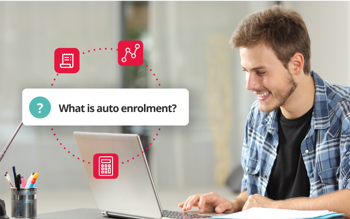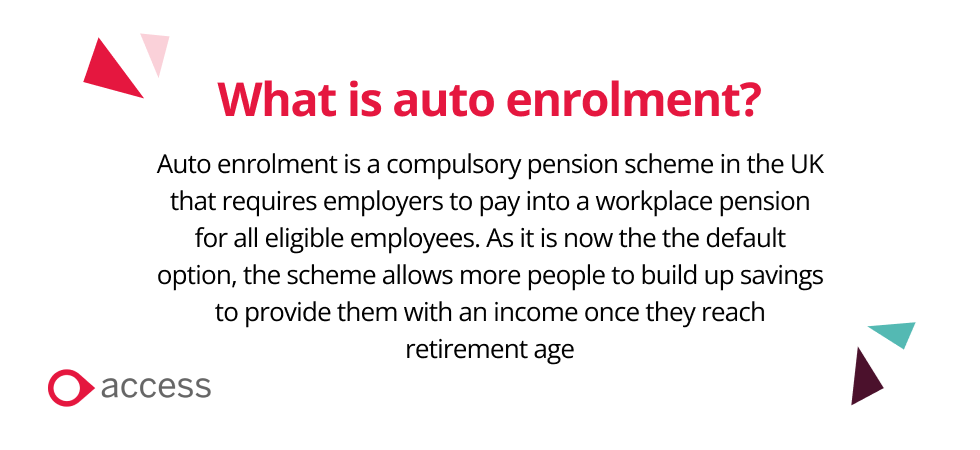
If you employ at least one person, you’re legally classed as an employer and are required to pay into a workplace pension for eligible staff. This type of pension is known as auto enrolment, and is separate from private pensions that a business or employee may choose to pay into themselves. Understanding how the process work is important for employers to make sure they’re meeting their legal obligations, and that their payroll solution is able to support these contributions.
In this article, we’re going to look at what auto enrolment is in more detail, before delving into the specifics of which workers are eligible, and how to get started if you need to manage auto enrolment pensions for your employees.
What is auto enrolment?
Auto enrolment is a compulsory pension scheme in the UK that requires employers to pay into a workplace pension for all eligible employees. As it is now the default option, the scheme allows more people to build up savings to provide them with an income once they reach retirement age.
When did auto enrolment start?
It was previously up to individual employers to decide whether to offer a company pension, and employees could choose whether to enrol. However, in 2012, changes to the Pensions Act 2008 made it so that employers are now legally required to automatically enrol all eligible employees into a pension scheme.
These changes were rolled out gradually, starting with larger businesses, and now include employers of all sizes, even if they only employ one person. It’s therefore important to understand this type of pension, and how it affects your business. While compulsory, not all employees qualify for automatic enrolment. Let’s look at the criteria in more detail.
Who qualifies for auto enrolment?
Employees are eligible from their first day of employment, which is known as their duties start date. Whether they work full-time or part-time, you will need to enrol all employees into a workplace pension if they meet the following auto enrolment thresholds:
- They are classed as a ‘worker’
- They ‘normally’ work in the UK
- They are over the age of 22, but under the current State Pension age
- They earn more than £10,000 a year
There are certain criteria that make employees ineligible for auto enrolment, such as if they have already taken a pension organised by your company that meets the automatic enrolment rules, or if they have given or received notice that they are leaving their role. However, in most cases, employees who meet the thresholds will be eligible.
What are the qualifying earnings for auto enrolment?
An employee must earn more than £10,000 a year to qualify for auto enrolment. For all eligible employees, you must automatically enrol them and pay in at least the minimum contributions. If you’re not required to enrol them by law, employees may still choose to join your pension scheme if they want. However, you don’t have pay contributions if they earn these amounts or less:
- £520 a month
- £120 a week
- £480 over 4 weeks
What are the recent changes to auto enrolment?
The Department for Work and Pensions (DWP) recently confirmed that it will support proposals to further expand the scheme to allow more people to start saving for their retirement earlier. The changes will see the age for automatic enrolment lowered from 22 to 18, as well as the abolition of the lower earnings limit.
These discussions are currently still ongoing, and a date for the changes to come into effect has not yet been announced. For now, the current age and earning requirements still stand, but it’s worth being aware of these changes in advance so your business can start to prepare.
Can an employee opt out of auto enrolment?
While businesses are required to automatically enrol all eligible employees into a pension scheme, employees have the right to opt out at any time. If they opt out within a month of being enrolled in the scheme, they’ll be able to get back any payments they’ve already made. After this, any money they’ve paid in will remain in the pension until it’s claimed.
Employers must also give employees the opportunity to opt back into the scheme at least once a year, and must re-enrol employees at least every 3 years if they have opted out and are still eligible. This prevents workers from missing out on the chance to start saving for their future.
Getting started with auto enrolment
The process of setting up auto enrolment pensions for your employees can be daunting, particularly for smaller or newer businesses. However, there are lots of resources available to help you to get it right, such as this detailed guide from The Pensions Regulator.
To give you an overview, here are the main steps you need to take to get started with auto enrolment.
1. Assess eligibility
First, you need to work out which, if any, of your employees are eligible for auto enrolment by assessing them against the eligibility criteria on their duties start date.
2. Choose a pension scheme
Not all pension schemes are suitable for auto enrolment, so make sure you choose one that both you and your employees are able to pay into. It can take a while to select and set up the scheme, so it’s important to start this process as soon as possible. If you already have an existing pension scheme, you’ll need to check that it meets certain criteria for auto enrolment.
3. Enrol all eligible employees
You must enrol all eligible employees into the scheme, even if they’ve expressed a desire to opt out. Workers who wish to opt out can do so after they’ve been enrolled. You will then need to pay at least the minimum contribution throughout their time in the scheme.
4. Communicate to employees
No later than six weeks after their duties start date, you need to write to each member of staff to explain how auto enrolment applies to them. This is still the case even if they are not being enrolled in a scheme, or if they plan to opt out.
5. Declare your compliance
Even if you don’t enrol any of your employees into a pension scheme, you need to declare that you’ve met your legal obligations. You must do this no later than 5 months after an employee’s duties start date.
6. Regularly re-enrol employees who have opted out
At least every 3 years, you need to re-enrol employees who have opted out of the scheme on the anniversary of their duties start date. This gives them the chance to start saving, or to opt out again. You must complete a new declaration of compliance each time you re-enrol a member of staff.
Manage your payroll with us
Implementing a comprehensive payroll solution is a great way to help your HR team to manage auto enrolment pensions. By streamlining all of your payroll processes in one place and providing built-in compliance features, it helps you to stay on top of your legal obligations and ensure that employees are paid accurately and on time.
Get in touch with us to find out more about how we can help you to implement and manage your payroll processes.
